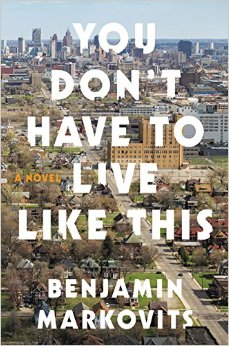by Andrew Hedglin
 On the first day I started working at Lemuria in June, my tour of the store concluded in the back of the store where we keep the ARCs (advance reader copies). I spent a few minutes looking at them, and the first one to really grab my eye was You Don’t Have to Live Like This by Benjamin Markovits. First, it had an eye-catching cityscape cover with big, white words superimposed onto an advancing Detroit skyline. Second, it’s hard to resist the comforting pull of those words, even and especially if they signal that the person hearing them is in a pretty bad place, and I had just left behind an ill-fitting career.
On the first day I started working at Lemuria in June, my tour of the store concluded in the back of the store where we keep the ARCs (advance reader copies). I spent a few minutes looking at them, and the first one to really grab my eye was You Don’t Have to Live Like This by Benjamin Markovits. First, it had an eye-catching cityscape cover with big, white words superimposed onto an advancing Detroit skyline. Second, it’s hard to resist the comforting pull of those words, even and especially if they signal that the person hearing them is in a pretty bad place, and I had just left behind an ill-fitting career.
The title comes from a fictional Obama speech in the middle of the novel, but it also applies to the protagonist and narrator of the novel, Greg Marnier (a.k.a. “Marny”), at both the beginning and end of the story. Marny, a Millenial in spirit if not age, quits his middling job in European academia before being approached by a college friend from Yale and politically ambitious hedge-fund millionaire, Robert James, with an intriguing opportunity: to help revitalize—or gentrify—some neighborhoods in Detroit. The project, eventually known as New Jamestown, sounds a bit like something you might hear about on an episode of This American Life and the shady economic dealings behind the scheme are something you would DEFINITELY hear about on Planet Money.
“Let me ask you a question. This is what I don’t understand. Those are some nice houses on Johanna Street, but what are you going to do when you get there?”
“I don’t know. I’m drifting for a bit right now.”
“Well, what are you good for?” she said.
This exchange occurs when Marny is—poorly, drunkenly—introducing himself at a party to his future love interest Gloria, an art teacher and native Detroiter. Marny helps fix up the house he lives in, writes a community newsletter, and becomes a substitute (then part-time) teacher. But he’s always a little underemployed, especially for somebody who enjoyed the benefit of an Ivy League education.
This preferred method of living is part of why I get why people would be frustrated, or even maddened, by Marny. But, ultimately, I think, he’s a gentle and empathetic, if somewhat self-interested, soul, who really does believe in New Jamestown. He thinks its residents really can build a community. Though he’s interested in exploring the lives of radically different people, because he tries to understand everybody’s point of view, he’s not very good at helping people from different groups communicate. And that’s when things go to hell.
Even if you don’t like Marny (who I think it helps to picture as acting and sounding somewhat like Jesse Eisenberg), there’s still a lot to love about this book. The story is sort of about race, definitely about privilege, partially about economics and class, and above all, it’s about cities and community. In the words of the great Rembert Browne, “ I care about cities, because that’s where people are forced to intermingle. I care about cities, because that’s where the culture is. And I care about my city above all, because it’s mine.” This book is about that hope to create, or desire to defend, that sense of ownership of a city, Detroit.
Sometimes that contact becomes conflict, and sometimes that conflict becomes conflagration. Two racially-charged incidents, one involving two of Marny’s closest friends, bring into sharp focus the tension between predominately white New Jamestown settlers and the predominately black Detroit natives. Since gentrification itself produces deep divisions, it doesn’t take much to turn a spark into a flame.
This might sound like a heavy story, but the breezy, funny-peculiar narration doesn’t read that way at all. The style is readable, un-self-concious and unliterary, even to the point of narrative apology at the very beginning of the book. It reminds me a little bit of books I’ve read by Jonathan Tropper, Richard Russo, Tom Perotta, or Meg Wolitzer (although the intended audience feels like it skews younger, generationally). It comes off as a little bit of a paperback read, but there’s enough depth and length to justify value as a hardback.
I don’t know. I’m still learning about how I don’t, and do, have to live. And living other people’s stories through books has always helped me do that.



Comments are closed.